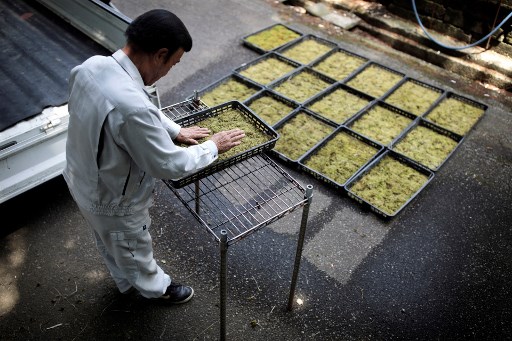
In recent years, moss enthusiasts have multiplied in Japan, with hikes catering to those eager to spot different varieties and shops selling the plants in terrariums well suited to small Japanese homes./ AFP PHOTO
by Harumi OZAWA
Agence France Presse
SAKUHO, Japan (AFP) — Kaori Shibo bent her head down and peered through a magnifying glass in a forest in central Japan, emitting a delighted gasp. The object of her adoration? Moss.
“Oh, this baby’s sporophyte is breaking out! I’ve never seen this before,” an enchanted Shibo, 41, shouted, her head nearly close enough to kiss a fallen tree log in the forest in Yatsugatake.
She was out on a stroll with around 20 other people who are part of a growing community in Japan obsessed with plants known as bryophytes, including moss, liverworts, and hornworts.
“When you stare at a tiny, tiny piece of green, you find a vast world expanding from there,” explained fellow moss enthusiast Masami Miyazaki.
“It’s like a micro-universe,” the 42-year-old said.
The group was out exploring just days into Japan’s rainy season, perfect weather for an expedition to spot some of the many mosses, liverworts, hornworts and lichens thickly coating the forest’s trees and rocks.
The forest, which surrounds Shirakomanoike lake and spreads across the northern Yatsugatake mountain range, is a popular spot for micro-plant enthusiasts.
More than 500 varieties can be observed in the Yatsugatake mountain range alone, according to Masanobu Higuchi, Japan’s leading bryology expert, and the hike’s leader.
“I am infatuated by moss not just because of their pretty shapes and colors,” Shibo said.
“I am transported by the fact that you can find them anywhere around you but never realize how magnificent they are.”
A staple of Japanese gardens
In recent years, moss enthusiasts have multiplied in Japan, with hikes catering to those eager to spot different varieties and shops selling the plants in terrariums well suited to small Japanese homes.
The Northern Yatsugatake Moss Association began organising moss viewing hikes in 2011, which attracted around 40 people over the year.
But this year, 140 people scored tickets to the association’s hikes, which are held each month until October, with demand outstripping the number of spots available.
Moss has been popular with traditional Japanese gardeners for centuries, and the plants grow well in the country’s humid climate.
“A beautiful natural landscape that is taken and compacted, that is the essence of Japanese gardens,” said Chisao Shigemori, a prominent Japanese garden designer.
Speaking to AFP at the carefully groomed Japanese garden at Kyoto’s Tofukuji temple, he said moss is considered the best ground-covering plant for such traditional settings because it helps replicate natural landscapes in miniature.
“The landscape of mountains and contrasting densities of green can be all expressed by moss,” he said.
At the temple, much of the garden is covered with juniper haircap, known as “sugi-goke” or cedar moss in Japanese.
The spiky stems resemble miniature cedar trees and the moss is very popular with Japanese garden designers.
The ‘Moss King’
While moss is a purely aesthetic pleasure for some Japanese, for others it is also big business.
Nicknamed the ‘Moss King’, 64-year-old Oichi Kiyomura spends most days digging through wild bushes, across slopes and even up cliffs, looking for moss he can scoop into trays and sell to enthusiasts.
It’s a far cry from his former career, running nightclubs, but Kiyomura, who is based in the mountains of Nikko north of Tokyo, says his moss business is lucrative.
He says he makes at least 30 million yen ($270,000) a year, hinting that is a modest estimate.
His moss conversion came one day when he was out mushroom picking with a friend.
“It was something I had never expected, but I found a really beautiful community of moss, clustered in the shape of small domes. It was my first encounter with moss,” he said.
It was a type known locally as “arahashiraga-goke”, popular among bonsai farmers for its silk-like fine leaves.
“I thought there was no way that people would ignore something so beautiful if I started selling it.”
He purchased vast lots of land, including some alongside a shuttered golf course left behind when Japan’s economic bubble burst, and started gathering the micro-plants.
He now sells to temples, traditional garden designers, bonsai farmers and terrarium hobbyists.
He has even developed a greening system that allows moss to be grown on building roofs in cities to help bring down temperatures.
Kiyomura acknowledges some detractors find moss rather pedestrian and uninteresting, but he defends his obsession with the plants.
“I love moss, even more than women,” he joked. “I would live with it even if no one cared about it anymore.”
© Agence France-Presse







